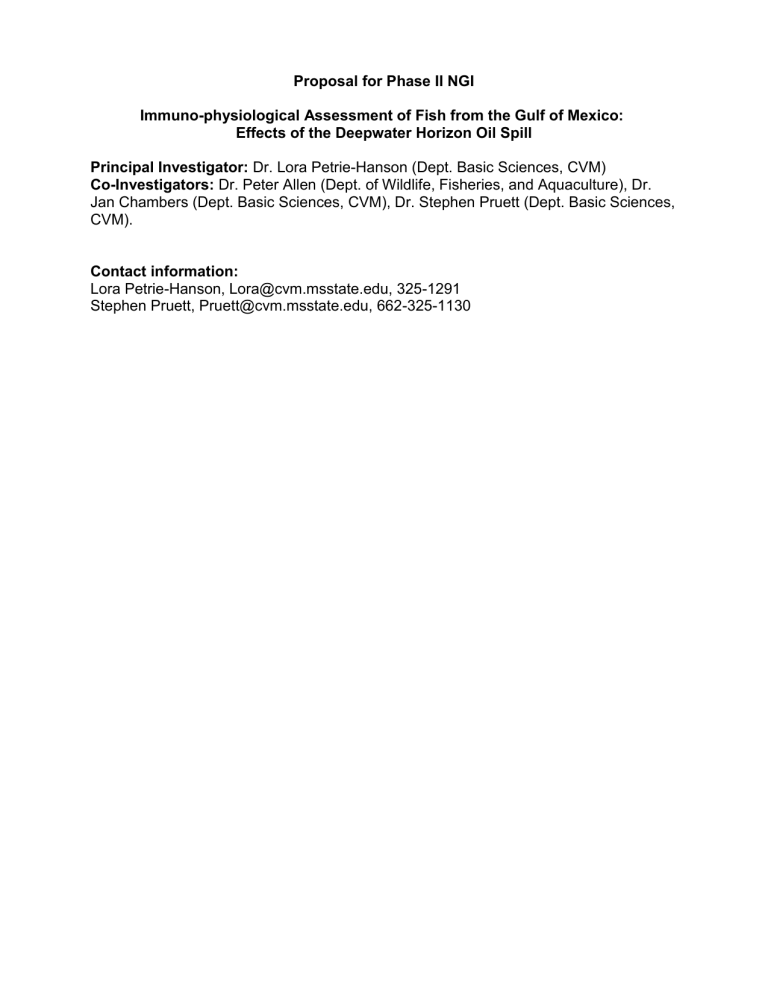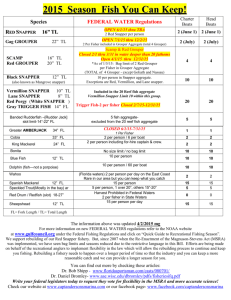COUOne-pager-NGI-PhaseII-rev

Proposal for Phase II NGI
Immuno-physiological Assessment of Fish from the Gulf of Mexico:
Effects of the Deepwater Horizon Oil Spill
Principal Investigator: Dr. Lora Petrie-Hanson (Dept. Basic Sciences, CVM)
Co-Investigators: Dr. Peter Allen (Dept. of Wildlife, Fisheries, and Aquaculture), Dr.
Jan Chambers (Dept. Basic Sciences, CVM), Dr. Stephen Pruett (Dept. Basic Sciences,
CVM).
Contact information:
Lora Petrie-Hanson, Lora@cvm.msstate.edu, 325-1291
Stephen Pruett, Pruett@cvm.msstate.edu, 662-325-1130
Background: Fish population declines began in the year following the Exxon Valdez Oil Spill
(EVOS) (1) and increased occurrence of fish diseases occurred in the years following the EVOS
(2). Carls demonstrated that laboratory exposures of oil resulted in decreased inflammatory cells, leading to immunosuppression (2). Following the Deepwater Horizon oil spill, we can examine the functions of fish immune cells and define how crude oil and contaminant aromatic hydrocarbons affect the immune system, resulting in increased disease susceptibility in fish.
Objectives and Methods: Alligator gar ( Atractosteus spatula ) from affected sites along the Gulf of Mexico have been sampled via near-shore and estuarine sampling. Oil-exposed red snapper
( Lutjanus campechanus ) have been sampled via offshore research vessels in cooperation with the National Oceanic and Atmospheric Administration (NOAA). Future sample collection trips have been scheduled, but examining these fish without established baseline data could result in invalid interpretations of data. To validate collected samples with baseline data, we propose additional controlled studies using alligator gar as an in vivo model for controlled parametric studies of the effects of crude oil exposure on immune system functions and the metabolomic response of fish. We will investigate the correlations between immunological and physiological responses to crude oil exposure. This will allow us to evaluate its’ potential to pre-dispose fish to infectious disease.
Dr. Peter Allen has obtained an agreement from BP to provide samples of 3 different types of crude oil. Oil will be added to tanks with fish at several concentrations to establish doseresponse effects. Dr. Allen will cannulate alligator gar through the caudal vasculature enabling us to obtain blood samples at regular time intervals for immunological and metabolomic analyses (3)(4). These samples will be analyzed by flow cytometry, and lymphoid tissues will be stained for cytochemical immune profiles (5)(6)(7) to monitor the time course of immunological and physiological changes. Liver samples will be measured for enzyme activity (liver ethoxyresorufin O-deethylase [EROD]). Terminal blood and tissue samples will be measured for metabolomic profile and plasma ion concentrations (vapor-pressure osmometer) and lymphoid tissues will be stained for cytochemical immune profiles (5)(6).
The flow cytometer purchased with funding from an NSF RAPID grant will be used for functional assays to determine immune system status. These include phagocytosis and production of reactive oxygen species. Lymphocyte activation in response to concanavalin A will be assessed by increased size of cells and increased cells entering the cell cycle (determined by propidium iodide staining of fixed and permeabilized cells). Blood smears will be obtained for differential counts. Cell killing assays will evaluate the ability of isolated cells to kill heterologous non-self cells for target cells. The protocols of Bottley (8) and Hogan (9) will be used as guidelines.
Killing of target cells will be assessed using flow cytometry based on pre-staining of target cells with cell tracker orange and identification of killed cells with 7 amino-actinomycin D (10).
Red snapper exposed to offshore oil will be collected in cooperation with NOAA. Peripheral blood and lymphoid tissues will be collected. Blood will be preserved and later analyzed by flow cytometry. Lymphoid tissues will be stained for cytochemical and histopathological analyses.
Control red snapper will be sampled in cooperation with the Gulf Coast Research Laboratory.
Expected Results and Significance: We expect fish from exposed areas to exhibit immunosuppression compared to fish from unexposed or minimally exposed areas. However, if we find no differences, this will indicate that the effects of this warm water spill are different from those reported after the Exxon Valdez spill, which caused disease outbreaks in fish. By measuring polycyclic aromatic hydrocarbons (PAH), which are found in petroleum and persist and bioaccumulate in fish, we will be able to estimate exposure history. A correlation between immunological functions and PAH concentration will suggest the oil spill as the cause of the immunological dysfunction.
References Cited
1. Thorne, R., and G. Thomas. 2008. Herring and the 'Exxon Valdez'oil spill: an investigation into historical data conflicts. J Marine Sci 65:44-50.
2. Carls, M., G. Marty, T. Meyers, R. Thomas, and S. Rice. 1998. Expression of viral hemorrhagic septicemia virus in pre-spawning Pacific herring ( Clupea pallasi )exposed to weathered crude oil. Can J Fish Aquat Sci 55:2300-2309.
3. Allen, P.J., C. C. Barth, S. J. Peake, M. V. Abrahams and W. G. Anderson. (2009a).
“Cohesive social behaviour shortens the stress response: the effects of conspecifics on the stress response in lake sturgeon Acipenser fulvescens .” J Fish Biol 74 : 90-104.
4.
Allen, P. J., J. J, Cech, Jr., and D. Kultz. (2009b). “Mechanisms of seawater acclimation in a primitive anadromous fish, the green sturgeon”. J Comp Phys B 179 (7): 903-920.
5.
6.
7.
8.
9.
Petrie-Hanson, L. and A. J. Ainsworth (2000). "Differential cytochemical staining characteristics of channel catfish leukocytes identify cell populations in lymphoid organs." Veterinary Immunology and Immunopathology 73 (2): 129-144.
Petrie-Hanson, L. and A. E. Peterman (2005). "American paddlefish leukocytes demonstrate mammalian-like cytochemical staining characteristics in lymphoid tissues."
Journal of Fish Biology 66 : 1101-1115.
Petrie-Hanson, L., C. Hohn and L. Hanson (2009). "Characterization of rag1 mutant zebrafish leukocytes." BMC Immunology 10 (8)
Bottley, G., G. Cook, and G. Blair. 2007. A Flow Cytometric Assay for Analysis of
Natural-Killer Cell-Mediated Cytolysis of Adenovirus-Transformed Cells. In Adenovirus
Methods and Protocols: Ad Proteins, RNA, Lifecycle, Host Interactions, and
Phylogenetics, Second ed. W. A. T. Wold, ed. Humana Press, Inc., Totowa, NJ. 221-
230.
Hogan, R., T. Stuge, L. Clem, N. Miller, and V. Chinchar. 1996. Anti-viral cytotoxic cells in the chanel catfish ( lctalurus punctatus ). Developmental and Comparative Immunology
22:115-127.
10. Kim, G. G., V. S. Donnenberg, A. D. Donnenberg, W. Gooding, and T. L. Whiteside.
2007. A novel multiparametric flow cytometry-based cytotoxicity assay simultaneously immunophenotypes effector cells: comparisons to a 4 h 51Cr-release assay. J Immunol
Methods 325:51-66.
Budget
The NSF RAPID grant was used to purchase the major instrumentation needed for this project, a FACSAria III flow cytometer and cell sorter. Matching funds were required and these were provided by the Department of Basic Sciences, CVM Office of Research and Graduate Studies,
MAFES, the Office of the Vice President for the Division of Agriculture Forestry and Veterinary
Medicine, and NGI. The funds requested include the work outlined in the NSF RAPID grant application.
Supplies for immunological analyses of gar and snapper
Gar: fish holding and surgeries, oil exposures, metabolomic analyses
$9500.00
$9500.00
$2733.00
$9020.00
Travel for alligator gar pick-up and analyses
Toxicology, tissue samples and controlled exposure analyses
Travel and related expenses for red snapper sampling
Travel to present results at a national meeting
Publication costs
Total
$6000.00
$2000.00
$1200.00
$39953.00










